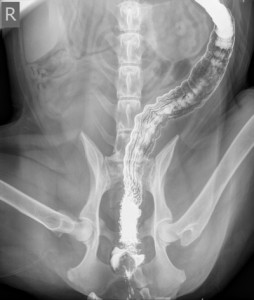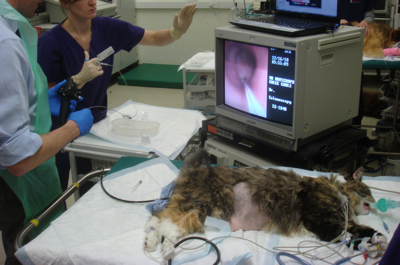 Diarrhoea refers to an increase in the water content of faeces which results in ‘loose motions’. The severity of diarrhoea, and the consequent need for veterinary attention, can be enormously variable.
Diarrhoea refers to an increase in the water content of faeces which results in ‘loose motions’. The severity of diarrhoea, and the consequent need for veterinary attention, can be enormously variable.
‘Acute’ Versus ‘Chronic’
Just as in human beings the majority of bouts of diarrhoea in dogs and cats are acute (short in duration – the terms ‘acute’ and ‘chronic’ have nothing whatsoever to do with severity but with duration) and will resolve by themselves. Often such ‘self-limiting’ bouts are due to an animal eating something that may be ‘spoiled’, rotten or otherwise potentially harmful and the diarrhoea represents the body’s defence mechanism to eliminate any potential source of harm rapidly. Because the cause of these is usually something relatively harmless, and the bouts soon resolve, medical investigation and long term treatment is seldom necessary.

Treating Acute Diarrhoea
As with ourselves, simply providing plenty of fresh water, temporarily withholding food then reintroduction of small amounts of an easily digestible bland diet such as plain chicken and boiled rice or a little scrambled egg, is all that is required to provide some ‘gut rest’ and for the diarrhoea to settle.
In cases where very plentiful diarrhoea occurs, especially if accompanied by vomiting, a more proactive approach may need to be taken and this may include temporary provision of oral or intravenous rehydrating solutions if dehydration is identified as a risk. There is very little indication for antibiotics to be given in most cases of short-term diarrhoea.
Whilst there are many medical treatments which may act as ‘adsorbants’ purported to ‘soothe’ the gut, in many cases, just as in their human owners, dogs and cats with short bouts of diarrhoea require no treatment. Investigation as to a cause of acute diarrhoea in otherwise healthy cats and dogs is rarely undertaken since this is not only usually fruitless, but results in both unnecessary expense and, more importantly, potential for completely unnecessary medical tests to be performed on a pet.

Radiograph taken after barium has been administered into the large intestine to highlight the gut.
Chronic Diarrhoea
Unfortunately in some animals, diarrhoea is not self-resolving and when diarrhoea is continuing for more than 2-4 weeks we generally classify it as being ‘chronic’.
Although diarrhoea is commonly thought of as a sign of gastrointestinal disease, it should be borne in mind that it is also a common clinical sign of many ‘systemic’ (i.e. affecting the whole body) illnesses and also of diseases which may occur in areas of the body close-by the gastrointestinal tract and may subsequently ‘irritate’ it. Therefore we always have to consider in dogs and cats with diarrhoea whether the gastrointestinal tract may simply be an ‘innocent bystander’.
Sometimes the nature of the diarrhoea can implicate problems affecting a particular area of the gut. Presence of an increased urge and urgency to pass faeces, often accompanied by straining and passage of mucus, bright blood and faeces which looks encased ‘in sausage skin’ are cardinal signs of diarrhoea which is originating from the last part of the gut, the large intestine (colon). Such signs, which are referred to as colitis, can be worrisome, especially the sight of fresh blood. This is usually due to the fact that the colon has many blood vessels which sit close to the surface of the tissue and commonly ooze fresh blood in response to inflammation. Although it may look alarming this seldom results in serious blood loss.
What Causes Chronic Diarrhoea in dogs and cats?
There are very many possible causes and so investigation of chronic diarrhoea is not straightforward and, frustratingly, can take some time. Initially your vet will want to take a detailed history of the nature of the problem as well as pertinent information about your pet including previous diets and general medical history. A thorough physical examination is also then essential. If further investigation is necessary this may take several forms and it is not uncommon for quite a few veterinary visits to be required to make a diagnosis.
Tests may be recommended that may help determine if there is a ‘systemic’ cause for the diarrhoea or if it is likely to be due to problems primarily of the gastrointestinal tract. Diagnostic imaging (‘x-rays’, more properly referred to as radiographs, and ultrasound) can help show whether there are changes in the anatomy / position of the organs of the gastrointestinal tract and also whether there are abnormalities in organs adjacent to it, which may be causing the gut to be affected as an ‘innocent bystander’. Tests for pancreas function and to detect vitamin deficiencies which may occur with problems of nutrient absorption, and with alteration in the bacterial populations within the gut may be recommended.
Faecal samples are often also examined and these may detect parasites, some of which may occasionally be contracted despite routine worming, or bacterial infections. However, many bacteria which are commonly associated with infections in people are found normally in dogs and cats and it is unknown in many instances whether these are playing a role. If bacteria that could cause disease in ourselves are detected then it is especially important that family members carry out proper hygiene after handling pets and at meal times since the only risk to people comes from lack of hand-washing.
Endoscopy (use of a camera to look inside the gut and to take biopsies) and surgery are sometimes also needed to diagnose a cause of the diarrhoea.

Anaesthetised cat undergoing colonoscopy (examination of the large intestine by using an endoscope)
Food Allergies and Chronic Diarrhoea in Dogs and Cats
Treatment of chronic diarrhoea depends on the diagnosis made although often dietary trials are also used to determine whether a dietary intolerance may be present. Most medical specialists do not advocate use of blood tests to look for ‘food intolerances / allergies’ as currently the accuracy of such tests has been disappointing. If a dietary trial is being performed, it is absolutely essential that the test diet is strictly adhered to. All other foodstuffs (including treats and snacks) must be excluded if any meaningful conclusion is to be drawn. Even small amounts of a food they are sensitive to can cause the diarrhoea to continue. A dietary sensitivity could then be missed leading to further medical tests and treatments that could have been avoided.
 The Veterinary Expert| Pet Health
The veterinary expert provides information about important conditions of dogs and cats such as arthrits, hip dysplasia, cruciate disease, diabetes, epilepsy and fits.
The Veterinary Expert| Pet Health
The veterinary expert provides information about important conditions of dogs and cats such as arthrits, hip dysplasia, cruciate disease, diabetes, epilepsy and fits.
 The Veterinary Expert| Pet Health
The veterinary expert provides information about important conditions of dogs and cats such as arthrits, hip dysplasia, cruciate disease, diabetes, epilepsy and fits.
The Veterinary Expert| Pet Health
The veterinary expert provides information about important conditions of dogs and cats such as arthrits, hip dysplasia, cruciate disease, diabetes, epilepsy and fits.